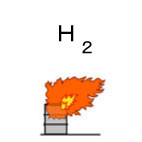| Case Name |
Leakage and fire from a reactor flange during shutdown operation at a hydrogenation plant of pyrolysis gasoline |
| Pictograph |

|
| Date |
July 3, 1993 |
| Place |
Takaishi, Osaka, Japan |
| Location |
Chemical factory |
| Overview |
During shutdown operation at a pyrolysis gasoline hydrogenation plant, recycled gas leaked and ignited at the top flange of the hydrogenation reactor. Tightening torque of the bolt was insufficient at start-up due to insufficient tightening torque control; moreover, the insufficient tightening torque was aggravated by both falling temperature and pressure. Finally, gas leakage occurred. |
| Incident |
Temperature-pressure lowering operation started at a pyrolysis gasoline hydrogenation plant for a turnaround shutdown. Hydrogen and hydrocarbon leaked out through a reactor flange during the work, and a fire occurred.
Pyrolysis gasoline: Gasoline fractions generated by thermal cracking obtained from an ethylene plant as a by-product. The following are the main components: benzene, toluene, xylene, and styrene. The main purposes of hydrogenation are desulphurization and saturation of olefin such as styrene. |
| Processing |
Manufacture |
| Individual Process |
Reaction |
| Process Flow |
Fig2.Unit process flow
|
| Chemical Reaction |
Other |
| Substance |
Hydrogen, Fig3 |
| Pyrolysis gasoline |
| Type of Accident |
Leakage, fire |
| Sequence |
Temperature-pressure lowering operation of pyrolysis gasoline was carried out at a hydrogenation plant (usual operation pressure is about 2.8 MPaG, the temperature is about 350 °C) for a turnaround shutdown. Gas leaked out through the reactor top flange when it reached at a temperature of 150 °C and the pressure was 1.3 MPaG. A fire followed. The ignition source was considered to be static electricity at gas leakage. |
| Cause |
The leakage seemed to be caused by overlapping of following three factors.
1. Tightening torque of the bolts decreased as temperature fell.
2. There was slightly unbalanced tightening torque at the flange plane.
3. Composition of process gas was changed to very high-dense hydrogen, and the gas readily leaked. |
| Response |
Nitrogen was injected into the system. Initial fire fighting with a fire extinguisher. Water-spraying by the public fire brigade. |
| Countermeasures |
Quantitative torque control should be introduced into tightening control of flanges. |
| Knowledge Comment |
Insufficient tightening torque at startup might cause leakage under transitional conditions, even if there is no leakage during usual operation. It is important to carry out quantitative control of tightening torque. |
| Background |
Behind two causes out of three described above, the following two factors seemed to be remote causes.
1. The bolt tightening torque at start-up was insufficient.
2. Quantitative control of tightening torque was not carried out. Therefore, unbalanced tightening torque occurred. |
| Incidental Discussion |
There was a case in which tightening torque decreased when a temperature decline rate was too fast during the temperature lowering operation. |
| Reason for Adding to DB |
Example of leakage and fire during shutdown operation due to insufficient tightening torque at startup |
| Scenario |
| Primary Scenario
|
Organizational Problems, Poor Management, Poor Operation Management, Poor Value Perception, Poor Safety Awareness, Inadequate Risk Recognition, Carelessness, Insufficient Precaution, Mannerism, Planning and Design, Poor Planning, Poor Planning of Repair, Usage, Maintenance/Repair, Hot Bolting, Malfunction, Poor Hardware, Insufficient Tightening Force, Secondary Damage, External Damage, Leakage/Fire
|
|
| Sources |
Fire and Disaster Management Agency. Fire at secondary hydrogenation reactor. Accident cases of dangerous materials. 1993. pp.86-87.
Industry and Security. Inadequate tightening torque of bolt is a cause. Vol.9. No.38. pp.4-5(1993)
High Pressure Gas Safety Inst. of Japan. High-pressure gas protection overview -1994 edition - pp.170-171(1994).
|
| Financial Cost |
Under ¥ 10,000. (Fire and Disaster Management Agency) |
| Multimedia Files |
Fig3.Chemical formula
|
| Field |
Chemicals and Plants
|
| Author |
KOBAYASHI, Mitsuo (Office K)
TAMURA, Masamitsu (Center for Risk Management and Safety Sciences, Yokohama National University)
|